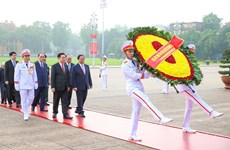Mekong Delta seeks ways for climate change adaptation
As from now, the stability of geomorphology and sea level rise will be
calculated when devising economic projects and plans in coastal and
estuary areas in the Mekong Delta.
As from now, the stability of geomorphology and sea level rise will be
calculated when devising economic projects and plans in coastal and
estuary areas in the Mekong Delta.
According to the Southwestern Steering Committee, the move aims to cope with climate change, which is forecast to affect natural and socio-economic environment in the country’s rice bowl in the next 50-60 years.
As part of the efforts, regional provinces will build large-scale maps featuring coastal and lowland areas, sub-regions based on rising sea levels and hydrographic and hydraulic areas in the sub-regions.
They will also make a list of infrastructure works which face the high risk of climate change and study new plant varieties highly resistant to salinity while upgrading sea and river dyke systems.
Besides, the localities build measures to protect production and infrastructure and evacuate people in vulnerable areas to safe places in case of calamity.
At the same time, they pay attention to information work and improving environmental management capacity while selecting high productivity and quality rice varieties which are resistant to salinity and adapt to climate change.
The Mekong Delta is one of the three most vulnerable delta belts that will face the onslaught and subsequent backlash of climate change in the world.
It is forecast that by the end of the century, sea water levels may rise by one metre – submerging 40 percent of the Mekong Delta, 11 percent of the Red River Delta and 3 percent of coastal provinces.-VNA
According to the Southwestern Steering Committee, the move aims to cope with climate change, which is forecast to affect natural and socio-economic environment in the country’s rice bowl in the next 50-60 years.
As part of the efforts, regional provinces will build large-scale maps featuring coastal and lowland areas, sub-regions based on rising sea levels and hydrographic and hydraulic areas in the sub-regions.
They will also make a list of infrastructure works which face the high risk of climate change and study new plant varieties highly resistant to salinity while upgrading sea and river dyke systems.
Besides, the localities build measures to protect production and infrastructure and evacuate people in vulnerable areas to safe places in case of calamity.
At the same time, they pay attention to information work and improving environmental management capacity while selecting high productivity and quality rice varieties which are resistant to salinity and adapt to climate change.
The Mekong Delta is one of the three most vulnerable delta belts that will face the onslaught and subsequent backlash of climate change in the world.
It is forecast that by the end of the century, sea water levels may rise by one metre – submerging 40 percent of the Mekong Delta, 11 percent of the Red River Delta and 3 percent of coastal provinces.-VNA













